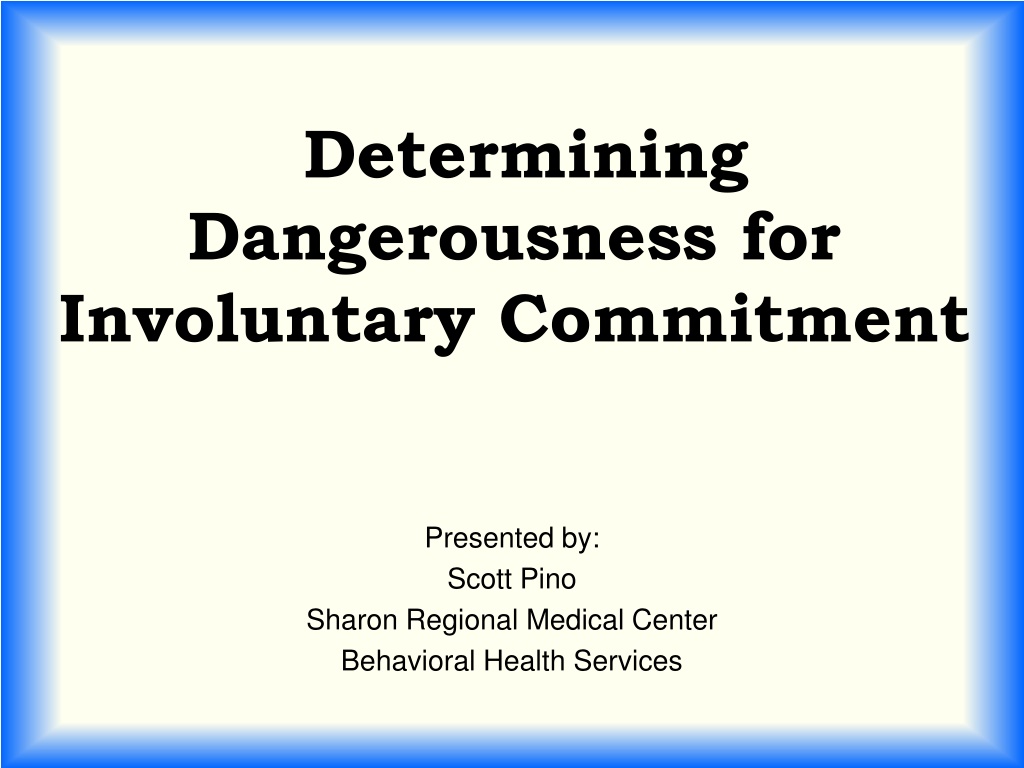Understanding Mental Health Procedures for Involuntary Commitment
The Mental Health Procedures Act, enacted in 1976 and amended in 1978, provides guidelines for the treatment of individuals with mental illness, emphasizing voluntary treatment over involuntary. It outlines criteria, such as evidence of severe mental illness and dangerous behavior, for pursuing involuntary evaluation and treatment. The act excludes certain groups and focuses on individuals' rights. PA Code Title 55 Chapter 5100.85 highlights the need for urgent mental health intervention in emergencies to prevent harm.
Download Presentation

Please find below an Image/Link to download the presentation.
The content on the website is provided AS IS for your information and personal use only. It may not be sold, licensed, or shared on other websites without obtaining consent from the author. Download presentation by click this link. If you encounter any issues during the download, it is possible that the publisher has removed the file from their server.
E N D
Presentation Transcript
Determining Dangerousness for Involuntary Commitment Presented by: Scott Pino Sharon Regional Medical Center Behavioral Health Services
Mental Health Procedures Act Enacted in 1976 (amended 1978) Designed to assure adequate treatment for individuals with mental illness Provides for Voluntary and Involuntary treatment Provides for Inpatient and Outpatient treatment Provides rights to individuals subject to treatment
Mental Health Procedures Act Changes from the MH/MR Act of 1966 were needed for a number of reasons: Multiple judicial decisions against the MH/MR Act. Need for Due Process under the 14thAmendment. Establishes/provides clear guidelines surrounding examination and treatment standards. Moved from medical model toward the recovery- oriented system we see today. Focused on rights to individuals subject to treatment.
Mental Health Procedures Identifies exclusionary groups Mentally Retarded Senile (Dementia or Organic) Alcoholic or Drug Dependent UNLESS they are also diagnosed as mentally ill Voluntary treatment is ALWAYS preferred
Mental Health Procedures To pursue INVOLUNTARY evaluation and treatment, the following MUST exist: 1) Evidence that an individual may be suffering from a severe mental illness 2) Evidence of dangerous behavior 3) Probability of Continuance or Recurrence 4) Immediate need for treatment 5) Expectation that treatment will be effective
PA Code Title 55 Chapter 5100.85 There is a definite need for mental health intervention without delay to assist a person on an emergency basis; The clear and present danger is so imminent that mental health intervention without delay is required to prevent injury or harm from occurring; There is reasonable probability that if intervention is unduly delayed the severity of the clear and present danger will increase; or There is reasonable probability that the person, with his presently available supports, cannot continue to adequately meet his own needs if mental health intervention is unduly delayed.
Evidence of Mental Illness Mental Health Procedures Act: A person is severely mentally disabled when, as a result of mental illness, his capacity to exercise self-control, judgment and discretion in the conduct of his affairs and social relations or to care for his own personal needs is so lessened that he poses a clear and present danger of harm to others or to himself.
Evidence of Mental Illness PA Code Title 55, Chapter 5100.2: Mental Illness--Those disorders listed in the applicable APA Diagnostic and Statistical Manual; provided however, that mental retardation, alcoholism, drug dependence and senility do not, in and of themselves, constitute mental illness. The presence of these conditions however, does not preclude mental illness.
Evidence of Dangerous Behavior There are four categories of dangerous behaviors identified within the MHPA and on the MH 783 (DHS- approved 302 form): 1. Harm to Others 2. Inability to Care for Self 3. Attempted Suicide 4. Self Mutilation
Evidence of Dangerous Behavior Clear and present danger to others shall be shown by establishing that within the past 30 days the person has inflicted or attempted to inflict serious bodily harm on another and that there is reasonable probability that such conduct will be repeated.
Evidence of Dangerous Behavior Clear and present danger to others may also be demonstrated by proof that the person has made threats of harm and has committed acts in furtherance of the threat to commit harm.
Evidence of Dangerous Behavior Clear and present danger to self .by establishing within the past 30 days the person has acted in such a manner as to evidence that he would be unable, without care, supervision and the continued assistance of others, to satisfy his need for nourishment, personal or medical care, shelter, or self-protection and safety, and that there is reasonable probability that death, serious bodily injury or serious physical debilitation would ensue within 30 days unless adequate treatment were afforded
Evidence of Dangerous Behavior Clear and present danger to self the person has attempted suicide and that there is reasonable probability of suicide unless adequate treatment is afforded under this act. For the purpose of this subsection, a clear and present danger may be demonstrated by the proof that the person has made threats to commit suicide and has committed acts which are in furtherance of the threat to commit suicide
Evidence of Dangerous Behavior Clear and present danger to self the person has substantially mutilated or attempted to mutilate himself substantially and that there is the reasonable probability of mutilation unless adequate treatment is afforded under this act. For the purposes of this subsection, a clear and present danger shall be established by proof that the person has made threats to commit mutilation and has committed acts which are in furtherance of the threat
Evidence of Dangerous Behavior What do you use to identify? Written or oral statements from individuals who have witnessed the behaviors Actions or behaviors of the 302 candidate Probability of recurrence Threats of harm plus acts in furtherance Timing - Must have occurred within the past 30 days
Evidence of Dangerous Behavior What do you use to identify? Intent of the individual behaviors do not necessarily have to be lethal (e.g.: three aspirin) Beliefs/perceptions of the individual that place them at risk (e.g.: walk across busy street) Lack of self-care/inability to care for self must be distinguished from poor hygiene or laziness
Mental Health Procedures To pursue INVOLUNTARY evaluation and treatment, the following MUST exist: 1) Evidence that an individual may be suffering from a severe mental illness 2) Evidence of dangerous behavior 3) Probability of Continuance or Recurrence 4) Immediate need for treatment 5) Expectation that treatment will be effective
Probability of Recurrence What do you use to identify? The age, medical condition, available support systems, and any known history of the individual (may extend beyond the last 30 days) Time elapsed between behavior and reporting to the Delegate The general emotional state of the individual Current conditions related to weather, season/time of year and other pertinent information
Probability of Recurrence If the person is voicing threats to repeat or continue dangerous actions toward self or others, it is safe to consider probable recurrence of previously demonstrated acts If the person is going through behaviors or actions similar to those that preceded the previous dangerous acts, it is generally safe to presume that another dangerous act will occur
Mental Health Procedures To pursue INVOLUNTARY evaluation and treatment, the following MUST exist: 1) Evidence that an individual may be suffering from a severe mental illness 2) Evidence of dangerous behavior 3) Probability of Continuance or Recurrence 4) Immediate need for treatment 5) Expectation that treatment will be effective
Immediate Need for Treatment Immediacy may be defined as: A situation which requires prompt intervention in order to prevent serious harm to the person or to someone else, where a delay would produce serious consequences.
Immediate Need for Treatment What do you use to identify? Current actions endangering the individual or others are ongoing Steps to fulfill a threat or plan for harm to the individual or others are undertaken Threats have been made to repeat a previous dangerous action that occurred within the last 30 days
Acts In Furtherance Not specifically defined within the MHPA Steps or actions taken toward the fulfillment of the threat Requires the gathering of detailed information or direct observation MHPA provides protection for the individual making these decisions: .
Mental Health Procedures Act Section 7114 Holds harmless any Administrator, Director, Physician, or other Authorized Person involved in the process, in the absence of willful misconduct or gross negligence. Harmless for either approval or denial of involuntary examination and treatment Includes criminal or civil liability
Mental Health Procedures Act Section 7301 Persons Who May Be Subject to Involuntary Examination and Treatment Person must be severely mentally disabled Must be in need of immediate treatment Must present clear and present danger of harm to others or to himself
Mental Health Procedures Act Protection of the Individual s Rights Provisions of the MHPA must be followed, regardless of the individual s living arrangements A doctor s order is not sufficient without the necessary petition and paperwork Criteria must be met in order to complete evaluation on an involuntary basis. Least restrictive measures must be utilized. Confidentiality must be maintained
Mental Health Procedures Act 7102. Statement of policy Treatment on a voluntary basis shall be preferred to involuntary treatment; and in every case, the least restrictions consistent with adequate treatment shall be employed.
PA Code, Title 55, Chapter 5100.3 (b): It is the policy of the Commonwealth to seek to assure that adequate treatment is available with the least restrictions necessary to meet each client s needs. While this policy remains a shared responsibility between State, county, and facility personnel, the accountability for recommending the transfer to the least restrictive alternatives available remains a responsibility of those directing treatment. Adequate treatment provided in an individual s own community or as close as possible to his own home shall be preferred.
Mental Health Procedures Act Section 7109 7112 Outline Written Application/Forms/Unsworn Statements, and Confidentiality of Records: DPW approved forms Unsworn falsification to authorities is criminally liable Disclosure of confidential information requires consent except for disclosure to: Those engaged in providing treatment County Administrator Court in the course of legal proceedings under this act Unless otherwise allowed by Federal rules/statutes/regs
Determining Dangerousness DISCUSSION & QUESTIONS























